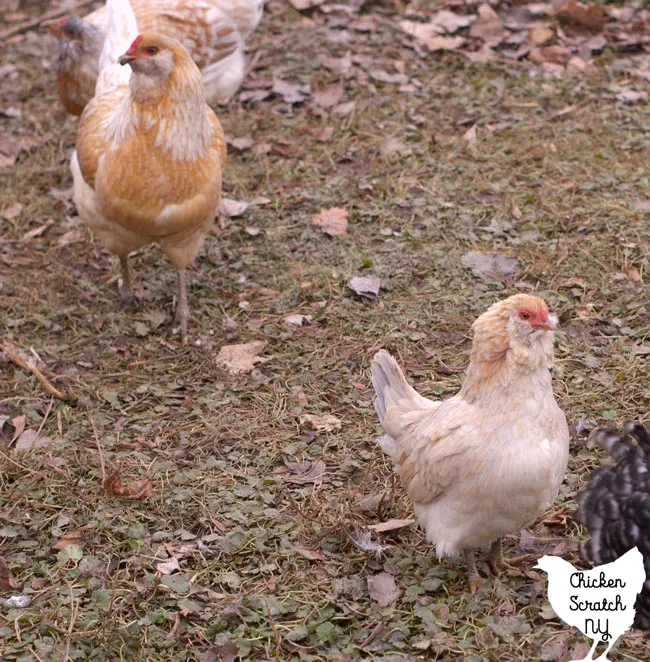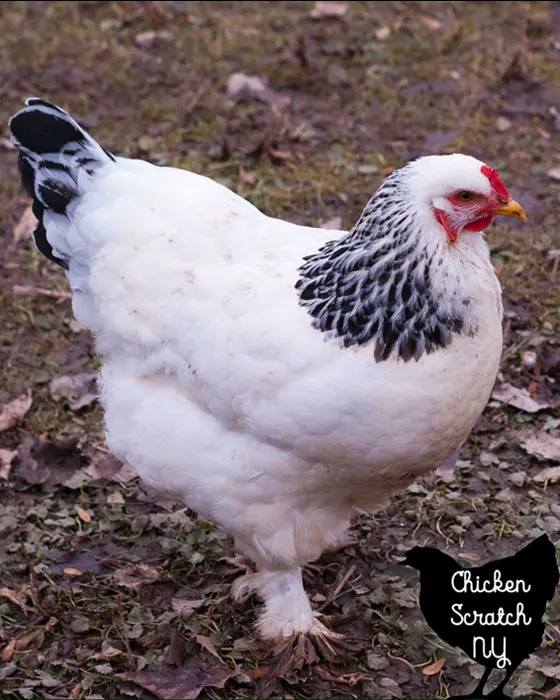Dual purpose chickens are bred for both egg production and meat. It may sound perfect but there is a trade off.

If you’re new to chickens and you’ve been perusing the catalogs planning your new chick order you might have come across the term ‘dual-purpose chicken’ and been confused or intrigued.
We all know chickens have more than two purposes but we’re going to ignore the lawn ornaments and exhibition breeds.
Egg Laying Chickens
All hens will lay eggs if they stay out of the freezer long enough but there are certain chickens bred specifically for laying eggs.
Egg laying breeds tend to have a slighter build, they put most of their energy into laying eggs, not bulking up. They are also less likely to go broody, when hens sit on eggs they stop laying and won’t start back up until they are done with their chicks.
The best layers in terms of numbers are going to the be hybrid layers. The egg-laying hybrid chicken breeds include Golden Comets and Cinnamon Queens. Both breeds can lay up to 320 eggs in their first year laying.
I have raised a few hybrid layers years ago and they were nice enough birds but they tend to burn out quickly and they were the only birds I’ve ever lost to ascites or waterbelly.
Some people keep the hybrid layers for a few years and then when they stop laying they cull them all and turn them into broth and soup. They don’t have a lot of meat but they still have that chicken-y flavor.

Easter Eggers, or the chickens that lay blue and green eggs, are hybrids but unlike the other birds I mentioned they weren’t developed for extreme egg production.
They are on the slight side and probably wouldn’t be worth dragging out the scalding pot. They can lay 200-280 eggs a year.
If you’d prefer to skip the hybrids you’ll be happy to know there are some common chicken breeds that will lay almost as many eggs as the hybrid ladies. White & Brown Leghorns can lay up to 300 white eggs per year and Rhode Island Reds can lay up to 280 brown eggs (these guys are dual purpose by the way!).
Popular Egg Laying breeds include:
- White & Brown Leghorn (220-300 white eggs/year)
- Easter Egger (200-280 blue/green eggs/year)
- Red Jungle Fowl (250-300 cream eggs/year)
- Cream Legbar (180-200 blue eggs/year)
- Appenzeller Spitzhauben (150 white eggs/year)
Meat Chickens
If eggs aren’t your thing and you just want some birds for the table meat birds are for you. Just like with the egg layers, if you want to maximize the return on your investment you want to look for Cornish Crosses.
Cornish cross are hybrid meat chickens that reach butchering size at 6 weeks. You need to be on your game with them too, you don’t want to keep these birds alive much longer than 10 weeks.
When I was growing up my grandparents raised Cornish crosses and compared to the laying flock they had it was like dealing with two different species.
Cornish crosses will eat themselves to death, grow so large they break their own legs, and drop dead from heart attacks. It probably goes without saying that Cornish Cross are not the birds you want if you’re looking for a flock of layers.
When I raised meat chickens I skipped over the Cornish crosses and went with Freedom Rangers. They grow slightly slower than the CC but still faster than the dual-purpose types.
Freedom Rangers are meat birds but they were developed to be heartier than the CC and will do better on a range or pasture.
Popular Meat breeds include:
- Jumbo Cornish Cross
- Freedom Ranger
- Dark Cornish
Dual Purpose Chickens
So you’ve got super layers and quick-growing meat birds, and right in the middle you’ve got the dual-purpose chickens. They lay more eggs than a meat bird (a lot more) and carry more weight than a layer.

It probably won’t surprise you to know that most of the classic barnyard chicken breeds like Buff Orpingtons and Barred Rocks are dual-purpose.
They are popular for a reason. Dual purpose birds are the classic farm bird that does everything, they do well free ranging, they are good at foraging, they lay lots of eggs and they hold enough meat on their bones to make it worth butchering.
A lot of the heritage breeds are considered dual purpose. These birds tend to be thiccc and hardy. They carry quite a bit more weight than a layer and tend to be good winter layers.
If you’re looking for a self-sustaining flock a dual purpose breed is a good choice. Broodiness has been bred out of many of the production layers but dual purpose hens tend to retain that habit.
Popular Dual Purpose breeds include:
- Barred & White Rock (200-280 brown eggs/year)
- Black Australorp (200-280 brown eggs/year)
- Buff Orpington (200-280 brown eggs/year)
- Buckeye (180-260 brown eggs/year)
- Dominique (180-260 brown eggs/year)
- Jersey Giant (180-260 brown eggs/year)
- Wyandottes (180-260 brown eggs/year)
- Light Brahma (180-240 brown eggs/year)
- Speckled Sussex (180-240 light brown eggs/year)
- Marans (180+ dark brown eggs/year)
- Standard Cochin (110-160 brown eggs/year)
Raising Dual Purpose Chickens for Eggs
When they aren’t going broody dual purpose chickens can be really good layers. They lay less frequently that the hybrid layers but they also lay for a longer time.
Rhode Island Reds/White and Barred Rocks will lay up to 280 eggs/year, Jersey Giants, Wyandottes and Buckeyes will lay up to 260 eggs/year, and Marans and Barnavelders will lay up to 200 eggs/year.

Dual purpose chickens are also known for being good winter layers. Bigger birds handle the cold weather easier and are able to put more energy into laying versus just surviving.
I keep lights in my coop so my poor New York birds don’t spend 18 hours a day in darkness but I still notice when the days start to get longer in January and February just based on my egg basket.
Most of my birds lay light brown eggs but during the coldest months I notice a larger proportion of dark brown eggs (coming from my Marans & Welsummers) and green eggs from my olive eggers. None of my white egg layers are dual purpose and I rarely get a white egg in the winter!
Read more about Picking Chickens for Rainbow Eggs
Raising Dual Purpose Chickens for Meat
You can buy or hatch out a batch of chicks and keep the hens for eggs and process the roosters after 6-9 months. Most hatcheries will sell male chicks for a low price just to get rid of them.
If you have the space to run a few dozen cockerels on pasture for a few months it’s not a bad way to fill the freezer. Dual purpose roosters will usually reach 6 pounds around 4.5 months.
Do you Need a Rooster in Your Flock? Find out
You will have plenty of time to get them processed before the hormones kick in and they turn into jerks. Deadlines aren’t as much of an issue with these guys because they grow so much slower than the Cornish Crosses.
Some dual purpose chicken breeds will get pretty big, like my favorites, the Brahmas. Brahma cockerels (male chickens less than one-year-old) can reach up to ten pounds and the roosters can hit 12 pounds.

Dual purpose breeds will look different on the table than the standard chickens you’re used to. One of the biggest differences is lack of giant breast meat, they will have large frames (more bones for stock!) and less meat over all. They also have more flavor and the meat won’t be quite as tender.
Crock pots are a great way to cook dual purpose birds, the slow cooking help relax and tenderize the meat. And don’t forget Coq Au Vin! The braised chicken dish is traditionally made with an old rooster.
Looking for more info? Check out my Chicken Keeping page or start here:



